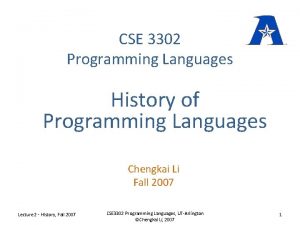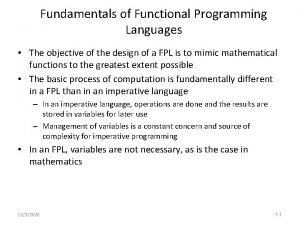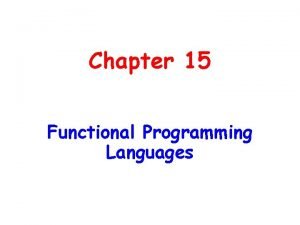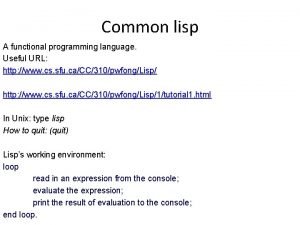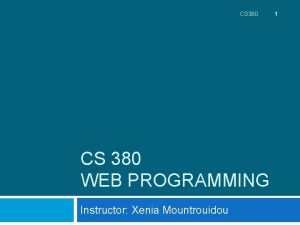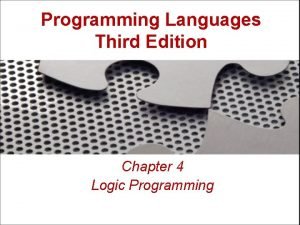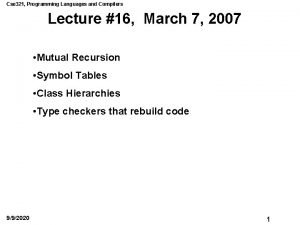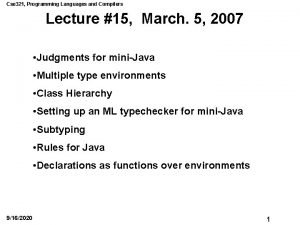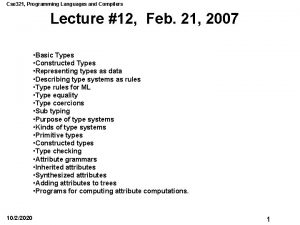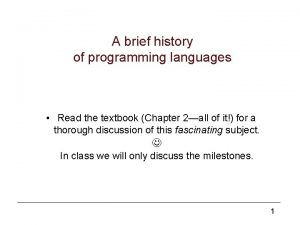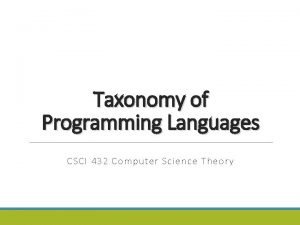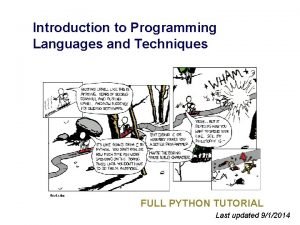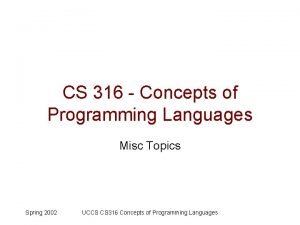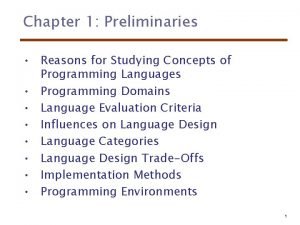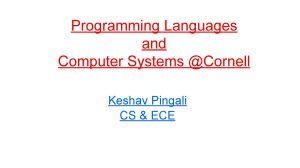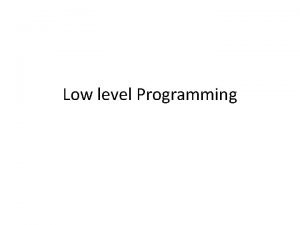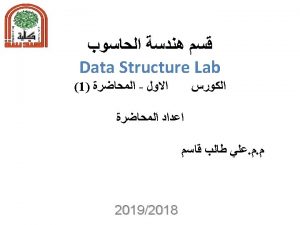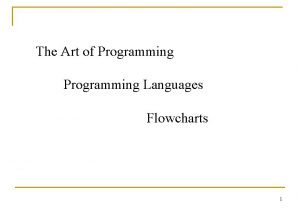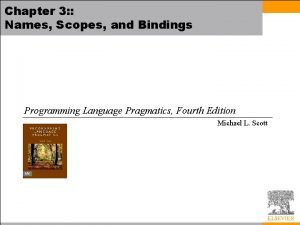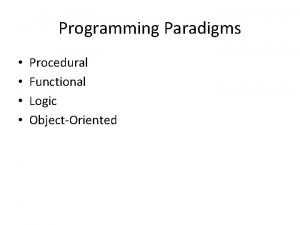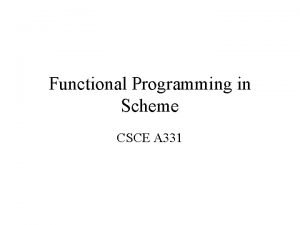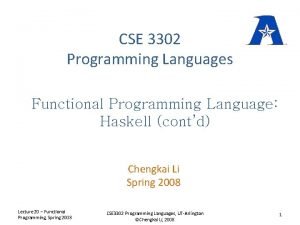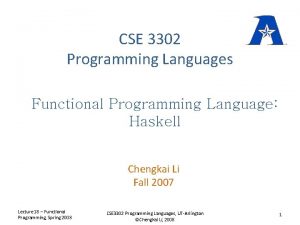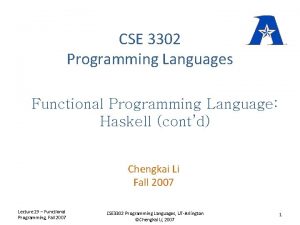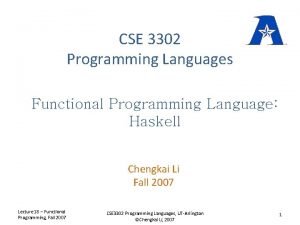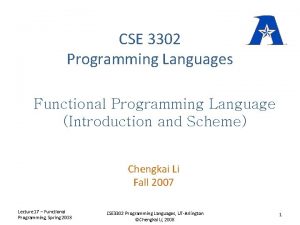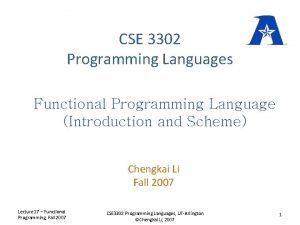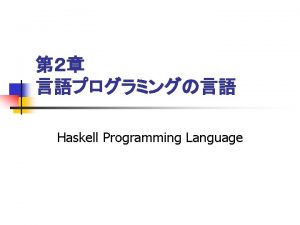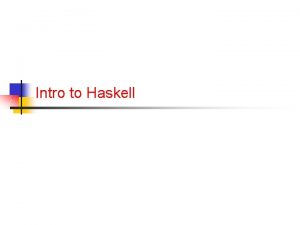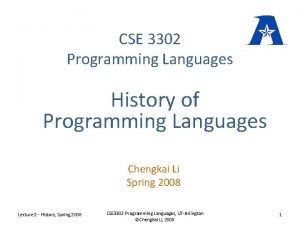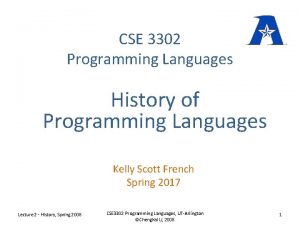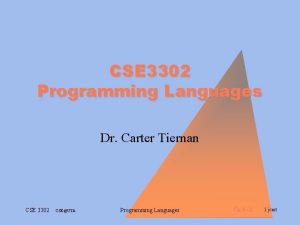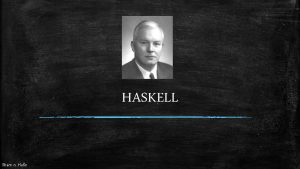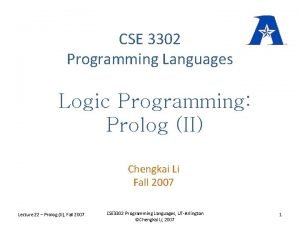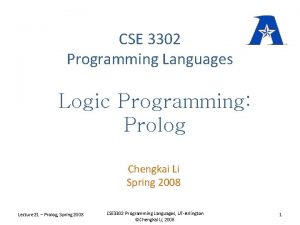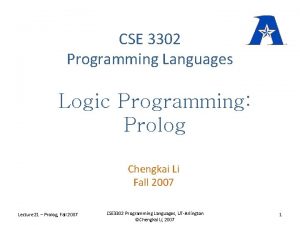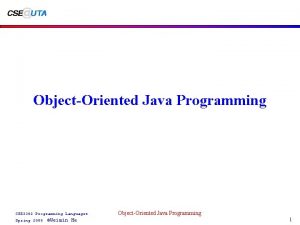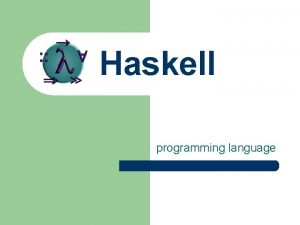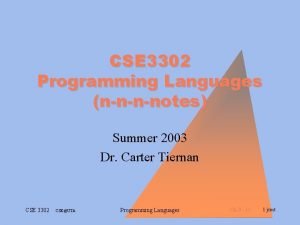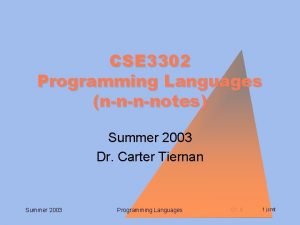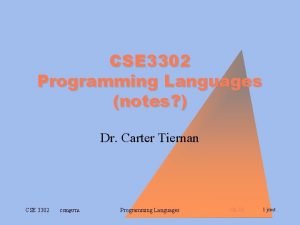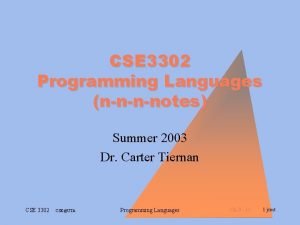CSE 3302 Programming Languages Functional Programming Language Haskell













































- Slides: 45

CSE 3302 Programming Languages Functional Programming Language: Haskell Chengkai Li Fall 2007 Lecture 18 – Functional Programming, Fall 2007 CSE 3302 Programming Languages, UT-Arlington ©Chengkai Li, 2007 1

Topics • • • Basics Types and classes Defining functions List comprehensions Recursive functions Higher-order functions Lecture 18 – Functional Programming, Fall 2007 CSE 3302 Programming Languages, UT-Arlington ©Chengkai Li, 2007 2

Notes • Haskell is not free-format. It has certain layout rules. • General rules to follow: – Indent the same amount for expressions at the same level – Don’t use tab • You need to use script (module) files to define functions, and use interactive environment to evaluate expressions (functions) Lecture 18 – Functional Programming, Fall 2007 CSE 3302 Programming Languages, UT-Arlington ©Chengkai Li, 2007 3

Basics Lecture 18 – Functional Programming, Fall 2007 CSE 3302 Programming Languages, UT-Arlington ©Chengkai Li, 2007 4

The Standard Prelude When Hugs is started it first loads the library file Prelude. hs, and then repeatedly prompts the user for an expression to be evaluated. For example: > 2+3*4 14 > (2+3)*4 20 Lecture 18 – Functional Programming, Fall 2007 CSE 3302 Programming Languages, UT-Arlington ©Chengkai Li, 2007 5

The standard prelude also provides many useful functions that operate on lists. For example: > length [1, 2, 3, 4] 4 > product [1, 2, 3, 4] 24 > take 3 [1, 2, 3, 4, 5] [1, 2, 3] Lecture 18 – Functional Programming, Fall 2007 CSE 3302 Programming Languages, UT-Arlington ©Chengkai Li, 2007 6

Function Application In Haskell, function application is denoted using space f a f(a) Lecture 18 – Functional Programming, Fall 2007 CSE 3302 Programming Languages, UT-Arlington ©Chengkai Li, 2007 7

Moreover, function application is assumed to have higher priority than all other operators. f a + b Means f(a) + b, rather than f (a + b). Lecture 18 – Functional Programming, Fall 2007 CSE 3302 Programming Languages, UT-Arlington ©Chengkai Li, 2007 8

Examples Mathematics Lecture 18 – Functional Programming, Fall 2007 Haskell f(x) f x f(x, y) f x y f(g(x)) f (g x) f(x, g(y)) f x (g y) CSE 3302 Programming Languages, UT-Arlington ©Chengkai Li, 2007 9

Script When developing a Haskell script, it is useful to keep two windows open, one running an editor for the script, and the other running Hugs. Start an editor, type in the following two function definitions, and save the script as Test. hs: (file name, without. hs, must match module name) module Test where double x = x + x quadruple x = double (double x) Lecture 18 – Functional Programming, Fall 2007 CSE 3302 Programming Languages, UT-Arlington ©Chengkai Li, 2007 10

Leaving the editor open, load the script: : load Test. hs File Test. hs must be in the right path. Use “File >> Options” to change the path Now both Prelude. hs and Test. hs are loaded, and functions from both scripts can be used: > quadruple 10 40 > take (double 2) [1. . 6] [1, 2, 3, 4] Lecture 18 – Functional Programming, Fall 2007 CSE 3302 Programming Languages, UT-Arlington ©Chengkai Li, 2007 11

After a script is changed, it is automatically reloaded when you save the file. You can also use a reload command: > : reload Lecture 18 – Functional Programming, Fall 2007 CSE 3302 Programming Languages, UT-Arlington ©Chengkai Li, 2007 12

Types and Classes Lecture 18 – Functional Programming, Fall 2007 CSE 3302 Programming Languages, UT-Arlington ©Chengkai Li, 2007 13

Types in Haskell We use the notation e : : T to mean that evaluating the expression e will produce a value of type T. False : : Bool not False : : Bool False && True : : Bool Lecture 18 – Functional Programming, Fall 2007 CSE 3302 Programming Languages, UT-Arlington ©Chengkai Li, 2007 14

Note: z Every expression must have a valid type, which is calculated prior to evaluating the expression by type inference; z Haskell programs are type safe, because type errors can never occur during evaluation; Lecture 18 – Functional Programming, Fall 2007 CSE 3302 Programming Languages, UT-Arlington ©Chengkai Li, 2007 15

Basic Types Haskell has a number of basic types, including: Bool - Logical values Char - Single characters String - Strings of characters Int - integers Lecture 18 – Functional Programming, Fall 2007 CSE 3302 Programming Languages, UT-Arlington ©Chengkai Li, 2007 16

List Types A list is sequence of values of the same type: [False, True, False] : : [Bool] [’a’, ’b’, ’c’, ’d’] : : [Char] [[’a’], [’b’, ’c’]] : : [[Char]] In general: [T] is the type of lists with elements of type T. Lecture 18 – Functional Programming, Fall 2007 CSE 3302 Programming Languages, UT-Arlington ©Chengkai Li, 2007 17

Tuple Types A tuple is a sequence of values of different types: (False, True) : : (Bool, Bool) (False, ’a’, True) : : (Bool, Char, Bool) (’a’, (False, ’b’)) : : (Char, (Bool, Char)) (True, [’a’, ’b’]) : : (Bool, [Char]) In general: (T 1, T 2, …, Tn) is the type of n-tuples whose ith components have type Ti for any i in 1…n. Lecture 18 – Functional Programming, Fall 2007 CSE 3302 Programming Languages, UT-Arlington ©Chengkai Li, 2007 18

Function Types A function is a mapping from values of one type to values of another type: not : : Bool is. Digit : : Char Bool (is. Digit is in script Char. hs) In general: T 1 T 2 is the type of functions that map arguments of type T 1 to results of type T 2. Lecture 18 – Functional Programming, Fall 2007 CSE 3302 Programming Languages, UT-Arlington ©Chengkai Li, 2007 19

Note: z The argument and result types are unrestricted. For example, functions with multiple arguments or results are possible using lists or tuples: add : : (Int, Int) Int add (x, y) = x+y zeroto n Lecture 18 – Functional Programming, Fall 2007 : : Int [Int] = [0. . n] CSE 3302 Programming Languages, UT-Arlington ©Chengkai Li, 2007 20

Curried Functions with multiple arguments are also possible by returning functions as results: add’ : : Int (Int Int) add’ x y = x+y add’ takes an integer x and returns a function. In turn, this function takes an integer y and returns the result x+y. Lecture 18 – Functional Programming, Fall 2007 CSE 3302 Programming Languages, UT-Arlington ©Chengkai Li, 2007 21

Note: z add and add’ produce the same final result, but add takes its two arguments at the same time, whereas add’ takes them one at a time: add : : (Int, Int) Int add’ : : Int (Int Int) z Functions that take their arguments one at a time are called curried functions. Lecture 18 – Functional Programming, Fall 2007 CSE 3302 Programming Languages, UT-Arlington ©Chengkai Li, 2007 22

z Functions with more than two arguments can be curried by returning nested functions: mult : : Int (Int Int)) mult x y z = x*y*z mult takes an integer x and returns a function, which in turn takes an integer y and returns a function, which finally takes an integer z and returns the result x*y*z. Lecture 18 – Functional Programming, Fall 2007 CSE 3302 Programming Languages, UT-Arlington ©Chengkai Li, 2007 23

Curry Conventions To avoid excess parentheses when using curried functions, two simple conventions are adopted: • The arrow associates to the right. Int Means Int (Int Int)). Lecture 18 – Functional Programming, Fall 2007 CSE 3302 Programming Languages, UT-Arlington ©Chengkai Li, 2007 24

z As a consequence, it is then natural for function application to associate to the left. mult x y z Means ((mult x) y) z. Unless tupling is explicitly required, all functions in Haskell are normally defined in curried form. Lecture 18 – Functional Programming, Fall 2007 CSE 3302 Programming Languages, UT-Arlington ©Chengkai Li, 2007 25

Polymorphic Types The function length calculates the length of any list, irrespective of the type of its elements. > length [1, 3, 5, 7] 4 > length ["Yes", "No"] 2 > length [is. Digit, is. Lower, is. Upper] 3 Lecture 18 – Functional Programming, Fall 2007 CSE 3302 Programming Languages, UT-Arlington ©Chengkai Li, 2007 26

This idea is made precise in the type for length by the inclusion of a type variable: length : : [a] Int For any type a, length takes a list of values of type a and returns an integer. A type with variables is called polymorphic. Lecture 18 – Functional Programming, Fall 2007 CSE 3302 Programming Languages, UT-Arlington ©Chengkai Li, 2007 27

Note: z Many of the functions defined in the standard prelude are polymorphic. For example: fst : : (a, b) a head : : [a] a take : : Int [a] Lecture 18 – Functional Programming, Fall 2007 CSE 3302 Programming Languages, UT-Arlington ©Chengkai Li, 2007 28

Overloaded Types The arithmetic operator + calculates the sum of any two numbers of numeric type. For example: > 1+2 3 > 1. 1 + 2. 2 3. 3 Lecture 18 – Functional Programming, Fall 2007 CSE 3302 Programming Languages, UT-Arlington ©Chengkai Li, 2007 29

This idea is made precise in the type for + by the inclusion of a class constraint: (+) : : Num a a For any type a in the class Num of numeric types, + takes two values of type a and returns another. A type with constraints is called overloaded. Lecture 18 – Functional Programming, Fall 2007 CSE 3302 Programming Languages, UT-Arlington ©Chengkai Li, 2007 30

Classes in Haskell A class is a collection of types that support certain operations, called the methods of the class. Eq Types whose values can be compared for equality and difference using (==) : : a a Bool (/=) : : a a Bool Lecture 18 – Functional Programming, Fall 2007 CSE 3302 Programming Languages, UT-Arlington ©Chengkai Li, 2007 31

Haskell has a number of basic classes, including: Eq - Equality types Ord - Ordered types Show - Showable types Num - Numeric types Lecture 18 – Functional Programming, Fall 2007 CSE 3302 Programming Languages, UT-Arlington ©Chengkai Li, 2007 32

Example methods: (==) : : Eq a a a Bool (<) a a Bool : : Ord a show : : Show a a String ( ) Lecture 18 – Functional Programming, Fall 2007 : : Num a a CSE 3302 Programming Languages, UT-Arlington ©Chengkai Li, 2007 33

Defining Functions Lecture 18 – Functional Programming, Fall 2007 CSE 3302 Programming Languages, UT-Arlington ©Chengkai Li, 2007 34

Conditional Expressions As in most programming languages, functions can be defined using conditional expressions. abs : : Int abs n = if n 0 then n else -n abs takes an integer n and returns n if it is non-negative and -n otherwise. Lecture 18 – Functional Programming, Fall 2007 CSE 3302 Programming Languages, UT-Arlington ©Chengkai Li, 2007 35

Conditional expressions can be nested: signum : : Int signum n = if n < 0 then -1 else if n == 0 then 0 else 1 Note: z In Haskell, conditional expressions must always have an else branch, which avoids any possible ambiguity problems with nested conditionals. Lecture 18 – Functional Programming, Fall 2007 CSE 3302 Programming Languages, UT-Arlington ©Chengkai Li, 2007 36

Guarded Equations As an alternative to conditionals, functions can also be defined using guarded equations. abs n | n >= 0 = n | otherwise = -n As previously, but using guarded equations. Lecture 18 – Functional Programming, Fall 2007 CSE 3302 Programming Languages, UT-Arlington ©Chengkai Li, 2007 37

Guarded equations can be used to make definitions involving multiple conditions easier to read: signum n | n < 0 = -1 | n == 0 | otherwise = 1 Note: z The catch all condition otherwise is defined in the prelude by otherwise = True. Lecture 18 – Functional Programming, Fall 2007 CSE 3302 Programming Languages, UT-Arlington ©Chengkai Li, 2007 38

Pattern Matching Many functions have a particularly clear definition using pattern matching on their arguments. not : : Bool not False = True not True = False not maps False to True, and True to False. Lecture 18 – Functional Programming, Fall 2007 CSE 3302 Programming Languages, UT-Arlington ©Chengkai Li, 2007 39

Functions can often be defined in many different ways using pattern matching. For example (&&) True False && && : : True = False = Bool True False can be defined more compactly by True && True = True _ && _ = False True && b = b z The underscore symbol _ is the wildcard pattern that matches any argument value. Lecture 18 – Functional Programming, Fall 2007 CSE 3302 Programming Languages, UT-Arlington ©Chengkai Li, 2007 40

List Patterns In Haskell, every non-empty list is constructed by repeated use of an operator : called “cons” that adds a new element to the start of a list. [1, 2, 3] Means 1: (2: (3: [])). Lecture 18 – Functional Programming, Fall 2007 CSE 3302 Programming Languages, UT-Arlington ©Chengkai Li, 2007 41

The cons operator can also be used in patterns, in which case it destructs a non-empty list. head : : [a] -> a head (x: _) = x tail : : [a] -> [a] tail (_: xs) = xs head and tail map any non-empty list to its first and remaining elements. Lecture 18 – Functional Programming, Fall 2007 CSE 3302 Programming Languages, UT-Arlington ©Chengkai Li, 2007 42

Lambda Expressions A function can be constructed without giving it a name by using a lambda expression. x -> x+1 The nameless function that takes a number x and returns the result x+1. Lecture 18 – Functional Programming, Fall 2007 CSE 3302 Programming Languages, UT-Arlington ©Chengkai Li, 2007 43

Why Are Lambda's Useful? Lambda expressions can be used to give a formal meaning to functions defined using currying. For example: add x y = x+y means add = x -> (y -> x+y) Lecture 18 – Functional Programming, Fall 2007 CSE 3302 Programming Languages, UT-Arlington ©Chengkai Li, 2007 44

Lambda expressions are also useful when defining functions that return functions as results. For example, compose f g x = f (g x) is more naturally defined by compose f g = x -> f (g x) Lecture 18 – Functional Programming, Fall 2007 CSE 3302 Programming Languages, UT-Arlington ©Chengkai Li, 2007 45
 Cse 3302
Cse 3302 Cse 340 principles of programming languages
Cse 340 principles of programming languages Cse 340 principles of programming languages
Cse 340 principles of programming languages Fundamentals of functional programming
Fundamentals of functional programming Fundamentals of functional programming language
Fundamentals of functional programming language Is lisp a functional programming language
Is lisp a functional programming language Real-time systems and programming languages
Real-time systems and programming languages Cs 421
Cs 421 Real time example of multithreading in java
Real time example of multithreading in java Programming languages levels
Programming languages levels Introduction to programming languages
Introduction to programming languages Plc programming languages
Plc programming languages Joey paquet
Joey paquet Comparative programming languages
Comparative programming languages Alternative programming languages
Alternative programming languages Strongly typed vs weakly typed
Strongly typed vs weakly typed Transmission programming languages
Transmission programming languages Integral data types
Integral data types Xenia programming languages
Xenia programming languages Advantages of high level language
Advantages of high level language Mainstream programming languages
Mainstream programming languages Programing languages
Programing languages Programming languages
Programming languages Programming languages
Programming languages Programming languages
Programming languages Tiny programming language
Tiny programming language Brief history of programming languages
Brief history of programming languages Lisp_q
Lisp_q Real time programming language
Real time programming language High level language
High level language If programming languages were cars
If programming languages were cars Reasons for studying concepts of programming languages
Reasons for studying concepts of programming languages Cornell programming languages
Cornell programming languages Low level programming languages
Low level programming languages Middle level programming languages
Middle level programming languages The art of programming language
The art of programming language Cs 421 programming languages and compilers
Cs 421 programming languages and compilers Multimedia programming languages
Multimedia programming languages Storage management in programming languages
Storage management in programming languages Cantilever type space maintainer
Cantilever type space maintainer Non functional plasma enzymes
Non functional plasma enzymes Enzymes of blood plasma
Enzymes of blood plasma Functional and non functional
Functional and non functional Hardware description language
Hardware description language Procedural vs functional
Procedural vs functional Scheme functional programming
Scheme functional programming
